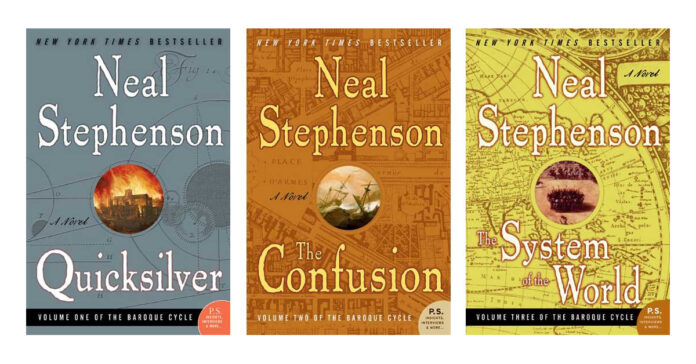I have long been a reader of science fiction and quickly embraced cyberpunk when it burst upon the scene. I never thought I would one day see cyberpunk novels on my bookshelf, such as The Peripheral by William Gibson, become a streaming series.
One of my favorite authors in the 1990s was Neal Stephenson, so when he published his trilogy known as the Baroque Cycle in 2003 through 2005, I read them all and was blown away.
Several weeks ago, I had a meeting at a library in our country. After the meeting, I browsed the shelves and found a hardcover copy of Quicksilver, the first book of The Baroque Cycle. This was a lucky find because I had books Two and Three on my shelf, but I apparently lost Book One in our move.
I applied for a library card and checked out the book. The librarian says something to the effect of, “I’ve often wondered about that book.”
I replied, “I’ve read it once or twice before; I’m looking forward to doing so again.”
“What’s it about?” she asked.
“Money,” I told her. “It is about the ebb and flow of money around the world. With inflation today, I think this is a good time to re-read it.”
She gave me a funny look and handed me the book
The Evolution of Money
I read it and just finished The Confusion, which is Book Two, I can say that I did both the librarian and Mr. Stephenson a disservice. Having re-acquainted myself with this book, it would be better to say that the Baroque Cycle is a world-spanning work of historical fiction in which a few key players are present for and often participate in many critical events that take place in Europe in the late 1600s. It is awe-inspiring in scope.
Wikipedia says, “A central theme in the series is Europe’s transformation away from feudal rule and control toward the rational, scientific, and more merit-based systems of government, finance, and social development that define what is now considered ‘western’ and ‘modern.’”
After rereading two thirds of it, I can say my 15-year-old memory that “the book is about money” is not wrong, just incomplete. While it is a book about many things, money is, in fact, a central theme. Hidden beneath a wide-ranging story are the creation of money, silver and gold as money, credit, the use of money and credit to finance wars, market manipulation via rumor and misinformation, global trade and commerce, the use of money as a weapon, the collapse of commerce and empires in the absence of money, the rise and fall of currencies, and, yes, inflation.
Lessons
This is not a prepper book, but that does not mean we cannot learn from it. Not only do the historical lessons about money remain important in today’s markets, the book’s other lessons are no less important. Namely, that with intelligence, perseverance, audacity, friends, and luck, even those born with the weight and momentum of society working against them may climb high, achieve much and have the last laugh. That’s a good lesson to remember. We may not all be heroes in a novel, but it surely doesn’t hurt to strive to be the hero in our own story.
My next step is to take a few days off to read a fast-paced action adventure novel in which tough, patriotic Americans overcome terrorists or other evildoers and save the country in the nick of time. That should give my brain enough of a rest that I can return to the serious work of Stephenson, the early 1700s, and Book Three of The Baroque Cycle.
If the idea of plowing through a trio of 900-word novels with multiple intertwined stores appeals to you, I recommend you get your mitts on a copy of Quicksilver by Neal Stephenson. If you make it through all three, take a break and then read Cryptonomicon by the same author. An excellent stand-alone book, it was written first and inspired the Baroque Cycle, but I think it is better read afterwards.


